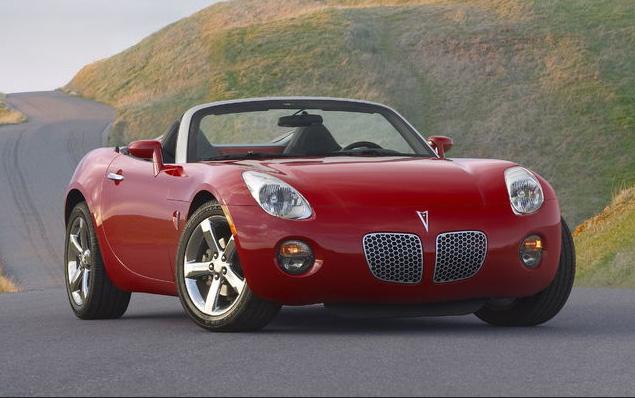Flashback Fridays: 2006 Pontiac Solstice
Story by John LeBlanc
Article originally published in October, 2005 – Knowing Mazda has had the affordable, rear-wheel-drive two-seater market to itself for more than a decade didn’t stop Bob Lutz from putting his reputation on the line when he drove the Solstice concept on-stage at the Detroit auto show in 2002. The vice-chairman of global product development for General Motors promised the production version would compete against the Mazda Miata in performance and price. Forty-six months (and one appearance on The Apprentice) later, Lutz’s promise is here, and the number of affordable roadsters on the market has just doubled.
Seeing the Solstice on the horizon, Mazda has redesigned its own roadster for 2006. It has a little more power, a bigger cabin, more aggressive styling and a new/old name — the MX-5. Despite the 15-year head start by Mazda, Pontiac’s rookie comes out swinging for the fences. Getting more attention than a naked Tyra Banks walking down the 401 handing out $1,000 bills is the Solstice’s sexy, show car looks. From the peaked front fenders to the Batmobile-like twin headrest fairings to the perky rear end, not since Audi’s TT has a concept car survived the production gauntlet so unscathed.
Compared with the MX-5, the Solstice’s cabin is noticeably wider. And with the cloth top up, there’s still plenty of headroom for my 5-foot-10 frame. Ergonomics are generally spot-on. The two steering column wands can be accessed with your fingertips without losing your grip on the steering wheel. The climate controls are a simple three-knob affair. The shift knob is stubby, with short throws. The placement of the foot pedals may break GM’s engineering rules, but it makes for easier heel-and-toe downshifts. And the Pontiac isn’t just a runway queen; it closely matches the smaller and lighter Mazda in acceleration. Especially noticeable are the Pontiac’s four-wheel disc brakes — firm from the outset, with tons of feel.
After a week of tooling around town receiving admiring looks (just the Solstice, not me) and a particularly enjoyable early-morning backroad blast, for the most part Lutz has a winner. GM created a smaller version of the Chevrolet Corvette’s chassis for the Solstice and added various bits from the General’s vast parts bin. Cobbled together the Pontiac is not. But it does lack the refinement of the Mazda, which benefits from its years of development.
For instance, the Cadillac-sourced rear suspension combined with the short/long control arms and Bilstein coil-over shocks front setup provides a comfy ride and very stable handling at elevated speeds. Unlike the MX-5, however — which allows the experienced driver to play with the steering, brakes and throttle when pushed hard — the Solstice’s big tires refuse to let go to the point of permanent understeer. The borrowed, economy-car Ecotec engine puts up good numbers, but it’s wheezy under 3,000 rpm, and it’s pretty raucous when you do apply the revs. Fifth gear in the Chevrolet Colorado-sourced tranny is looong, with top-gear acceleration suffering as a result.
Perhaps where the Solstice’s lack of refinement shows up most is in day-to-day driving. Except for the glovebox and a paperback-sized cubby between the vertical panel separating the seats, there is virtually no storage space in the Solstice’s cabin. No doorbins, no seat pockets, no console cubby, no cellphone bin — nada, zilch, nothing. The glare from the Pontiac Vibe-sourced instrumentation, the awkward placement of cup holders behind the driver’s right elbow and the big, hard plastic transmission tunnel where your elbow rests when stirring gears all make the car feel half-baked.
Then there’s the Solstice’s raison d’etre — the ragtop. Unlike the MX-5′s roof, which can be dealt with while remaining seated in the driver’s seat, those cool-looking, twin fairings are part of a rear-hinged trunk lid that first must be opened from the outside before the top can be stowed within. Putting the top up is even more tedious. You need to repeat the above in reverse, then latch the individual flying buttresses before hopping back in. Arghh! And because the Solstice uses a downsized Corvette chassis, where the MX-5 has a weekend’s worth of luggage trunk space, the Solstice has its rear suspension and gas tank. Great for nudists; for the rest of us, not so much.
Drive the Pontiac after the Mazda and the Solstice’s bigger form, hazy controls and indifferent handling make the drive less pure roadster, more boulevard cruiser.
So, Bob, the Solstice isn’t an MX-5 beater. But that’s not such a bad thing. The Solstice is great to be seen in, comfortable to sit in, affordable to buy and fun to drive. The basics are in place, and Pon-tiac won’t have a problem selling every one of the 100,000 units it has planned for the next five years — discounts, or not. In fact, if you love to drive, along with the Corvette and certain Cadillacs, this is one of GM’s best cars to date.
THE SPECS
TYPE OF VEHICLE: Rear-wheel-drive, two-seat roadster
ENGINE: 2.4L DOHC four-cylinder
POWER: 177 hp @ 6,600 rpm; 166 lb-ft of torque @ 4,800 rpm
TRANSMISSION: Five-speed manual
BRAKES: Four-wheel disc with ABS
TIRES: P245/45R18
PRICE: BASE/AS TESTED $25,695/$31,595
FUEL ECONOMY: L/100 km 12.1 city, 8.3 hwy.
STANDARD FEATURES: AM/FM/CD, cruise control, driver information centre, integrated fog lamps
OPTIONS: 18-inch polished aluminum wheels ($720), leather package ($2,110), power package ($1,040), limited slip differential ($255), ABS ($600), colour-keyed floor mats ($85), air conditioning ($1,200)
Article was originally published at Driving.ca






![[del.icio.us]](https://www.straight-six.com/wp-content/plugins/bookmarkify/delicious.png)
![[Digg]](https://www.straight-six.com/wp-content/plugins/bookmarkify/digg.png)
![[Facebook]](https://www.straight-six.com/wp-content/plugins/bookmarkify/facebook.png)
![[Google]](https://www.straight-six.com/wp-content/plugins/bookmarkify/google.png)
![[Reddit]](https://www.straight-six.com/wp-content/plugins/bookmarkify/reddit.png)
![[StumbleUpon]](https://www.straight-six.com/wp-content/plugins/bookmarkify/stumbleupon.png)
![[Twitter]](https://www.straight-six.com/wp-content/plugins/bookmarkify/twitter.png)
![[Email]](https://www.straight-six.com/wp-content/plugins/bookmarkify/email.png)